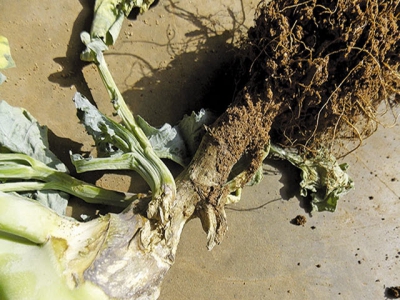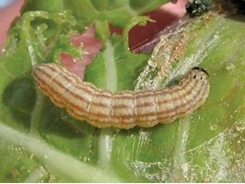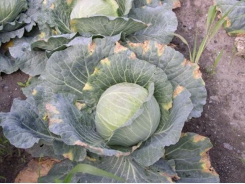Preventing blackleg in cabbage

Blackleg is a fungal disease that can be highly destructive. Fortunately, although there are no resistant varieties, it can be managed or prevented if you know how it spreads.
Blackleg on the lower stem of a cabbage plant.
Blackleg attacks just about all brassica crops, including canola and oil radish. Although the disease can be seed- borne, modern seed producers have reduced this risk with careful management techniques. Blackleg was a more serious problem in the days before hybrids, when there was much cost-cutting to sell seed more cheaply than the competition.
If you suspect that seed may be infected, place the seed in a muslin bag and suspend in hot water (about 50°C) for 25 to 30 minutes to cleanse the seed of the pathogen. Immediately thereafter, cool the seed by rinsing in tap water and then spread it thinly on newspaper to dry in the shade. If the seed is to be planted straight away, dry it sufficiently to work with. This also speeds up germination.
Modern hybrids are less likely to have blackleg-infected seed, and most seedlings are in any case produced in cavity trays. This means less chance of the fungus spreading at the seedling stage. However, if a seedling is infected, the fungus can spread when the seedlings are pulled and then watered.
The leaves of an infected seedling will have grey lesions with pinprick black spots. These are the pycnidia or fruiting bodies of the fungus. When these are ripe, an opening appears at the top through which the fungal spores escape. Spray the seedlings with the systemic fungicide benomyl at 1m/l water as a full cover spray. Bear in mind, however, that this method is effective only at the seedling stage.
Too easily overlooked
If the pathogen is in the seed (as opposed to the seedling), some plants will develop a reddish colour and eventually topple over. Examine the stem just above the ground and you will see a purpling. Cut diagonally down towards the root and a blackening under the skin will become visible. Often, these few plants don’t constitute much economic damage to your yield and are forgotten. But the fungus will survive in the tissue, especially the woody stems, and remain alive until it is broken down into humus.
Even with soil preparation, the stems are sometimes not buried properly and a year later, when a brassica crop is planted, the disease will strike again.
Learning a uselful lesson
I was once called in by a farmer who blamed the seed for a severe outbreak of blackleg. He was growing Brussels sprouts, which seem more susceptible to the disease. Half of the land was virtually unmarketable and the other half was clean. I soon established that the same seed batch had been planted in both sections.
It turned out that the infected half had been under cabbage the previous year. The farmer could not recall damage back then which, as noted, is often the case when only a few plants are infected. Rain splash can infect adjoining plants, or they can be infected at a later stage when they are not rendered unmarketable, but still carry the fungus.
Cyst eelworm and oil radish
Be extra careful if you have a cyst eelworm problem and plant oil radish as a trap crop. If the oil radish is planted in soil containing infected undecomposed brassica crop residue, blackleg will spread through the oil radish and the next brassica crop may be a disaster. I mention this because one does not usually pay much attention to oil radish. It is simply worked into the soil and then forgotten. But you should keep an eye out for any dying patches in the land, just to make sure.
On the Highveld, symptoms are usually found on the lower stem, but in seedbeds and moist climates, lesions may occur on all parts of the plant. If you farm in a moist climate, you should be especially vigilant.
Related news
Tools

Phối trộn thức ăn chăn nuôi

Pha dung dịch thủy canh

Định mức cho tôm ăn

Phối trộn phân bón NPK

Xác định tỷ lệ tôm sống

Chuyển đổi đơn vị phân bón

Xác định công suất sục khí

Chuyển đổi đơn vị tôm

Tính diện tích nhà kính

Tính thể tích ao




 Common Diseases of Greenhouse Plants
Common Diseases of Greenhouse Plants  Cabbage disease black rot
Cabbage disease black rot